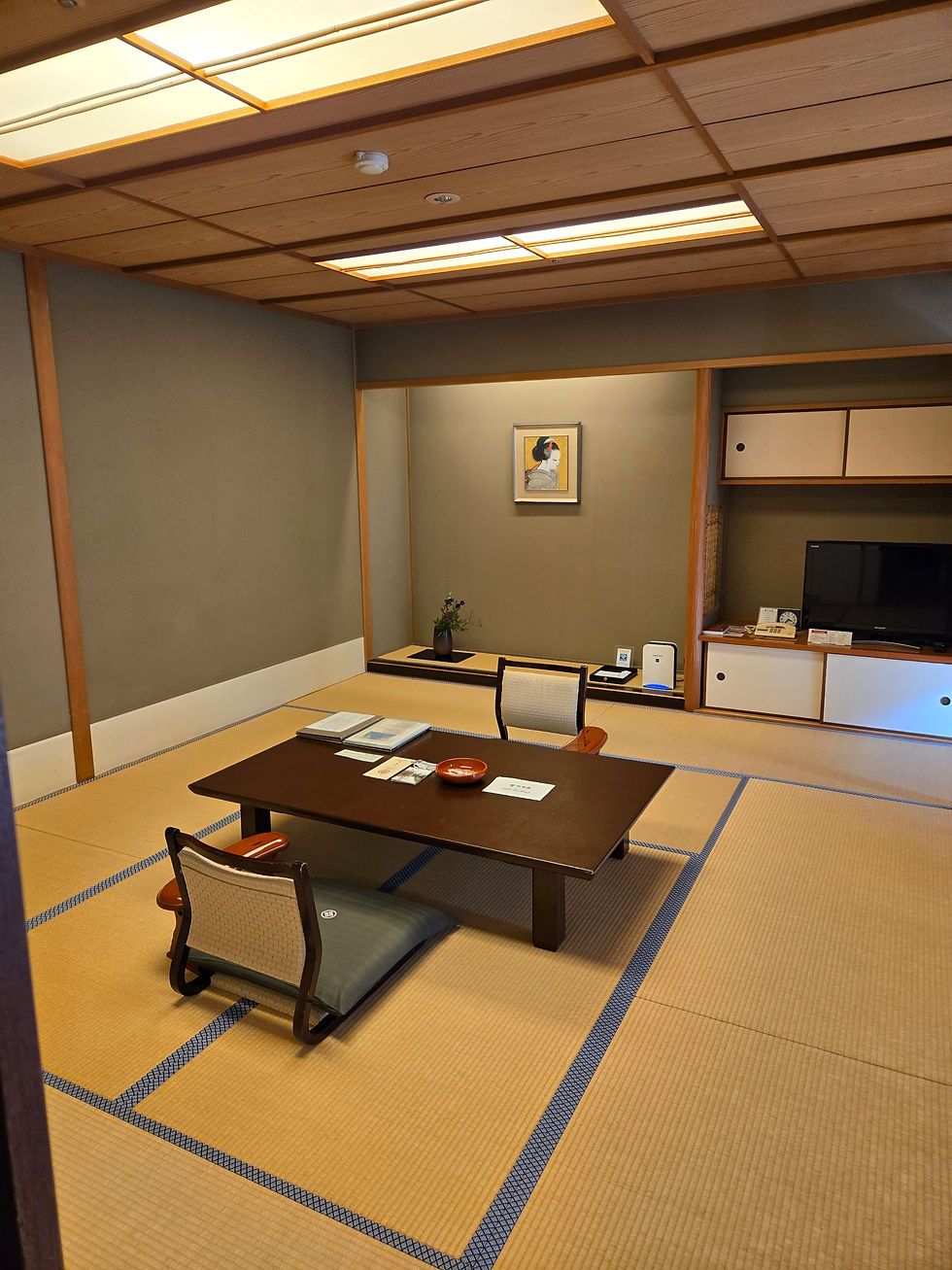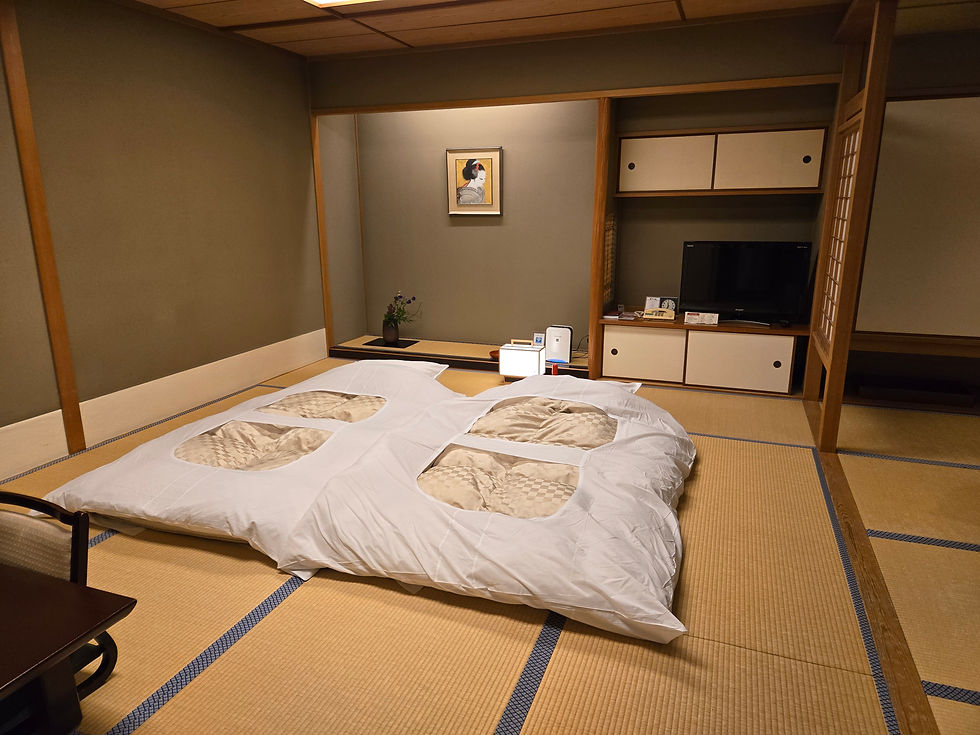Inside a Traditional Japanese Ryokan: Nishimuraya Hotel Shogetsutei in Kinosaki Onsen
- Amy Coleman
- Oct 30
- 5 min read
After a smooth JR West train ride from Osaka, Rachelle and I rolled our bags into the quiet, picture-perfect town of Kinosaki Onsen — a peaceful hot spring village tucked into the hills of Hyōgo Prefecture. Even though it’s just a few hours from Osaka, it feels like you’ve stepped into another era. Wooden buildings line the streets, yukata-clad guests stroll between bathhouses, and the whole town hums with slow, easy calm.
If you’ve ever dreamed of visiting a place that captures Japan’s old-world charm without the big-city crowds, Kinosaki is that hidden gem.
(Tip: If you get motion sickness on trains like Rachelle does, pre-medicate before heading out — Dramamine or motion patches are lifesavers!)
🎥 Watch Our Room Tour at Nishimuraya Hotel Shogetsutei!
Here’s a peek inside our ryokan room in Kinosaki Onsen. (Ignore the mic glitch halfway through — keeping it real 😉).
Checking In
Our destination was the Nishimuraya Hotel Shogetsutei, a traditional Japanese ryokan in Kinosaki Onsen surrounded by forested hillsides and private onsens. From the moment we arrived, the staff treated us with that warm, thoughtful hospitality Japan is famous for — bags whisked away, shoes swapped for slippers, tea waiting in the lobby.
The property itself was serene and elegant. Every view framed a touch of nature — soft moss, flowing water, or tall trees outside the window. It felt less like checking into a hotel and more like being invited into someone’s peaceful home.

Discovering Our Ryokan Room
The staff led us through softly lit hallways and sliding shoji doors until we arrived at our room — a superior Japanese-style suite, which honestly felt more like a serene apartment than a hotel room.
As soon as the door opened, we were greeted by that fresh tatami scent — earthy, clean, and calming. The space was warm, minimal, and quietly beautiful: paper screens, wooden beams, and a wide sitting area overlooking the hillside.
There was a little kitchenette with tea cups, a kettle, and a mini fridge stocked with Japanese beer and juice — the kind of small, thoughtful details that make you smile. And of course, slippers everywhere. In Japan, shoes are a big “no-no” indoors, and you’ll often switch footwear depending on where you’re standing — regular slippers for the main room, plastic ones for the bathroom.

Mind Your Bun (and Your Head!)
If you’re tall — or if you have your hair up in a bun like Rachelle did — you’ll quickly learn to duck through doorways. Japan’s traditional architecture was designed for smaller frames, and she definitely hit her hair bun on the top frame more than once. 😂
Still, the charm outweighs the bumps. Every element felt designed to slow you down: soft tatami floors, a low table for tea, and windows framing a perfectly peaceful hillside view.
And then… there was the key hole.
The “Low Key” Moment 😂
We went to lock our room when we left for dinner, we burst out laughing — the key hole was practically knee height! I swear it was the lowest I’ve ever seen in a hotel (or house for that matter). We just stood there cracking up, trying to imagine who designed it that way. It was one of those funny little cultural quirks that makes travel unforgettable.
Because travel isn’t just about picture-perfect views — it’s about the funny little details you’ll never forget.
Dinner Is Served — Experiencing a Traditional Japanese Ryokan in Kinosaki Onsen
Just when we thought the evening couldn’t get any more peaceful, there was a soft knock at the door — dinner time. At most ryokans, meals are served right in your room, and it’s truly an experience.
The staff quietly transformed our tea table into a dining setup and brought in course after course of what looked like edible artwork — small, perfectly arranged dishes showcasing local ingredients. There was fresh sashimi, miso soup, grilled fish, seasonal vegetables, and delicate desserts I couldn’t pronounce but happily devoured.
It wasn’t just food; it was art, and the presentation was as much a part of the experience as the flavors. Every dish was explained (in the gentlest mix of English and Japanese), and each piece of tableware was unique.

When Comfort Becomes a Cultural Experience
We traded our day clothes for yukata — light cotton robes provided by the hotel. Guests wear them throughout the ryokan, to dinner, and even while strolling to the public onsens in town. Each yukata came with a matching sash and traditional socks with a split toe for sandals.
There was even a little instruction card showing how to wrap and tie it properly — a lifesaver for first-timers like us.
(Pro tip: always wrap the left side over the right. The opposite way is used for funerals.)
Later, staff returned to quietly prepare our bedding — folding out futon mats and plush comforters right on the tatami floor. It’s surprisingly comfortable, and something about sleeping that close to the ground makes you feel grounded — literally.

The Onsen Experience
Kinosaki Onsen is famous for its seven public bathhouses, each with its own unique design and history. Guests staying in town can stroll between them in yukata and wooden sandals, using a day pass included with most hotels.
Nishimuraya also offers its own private onsen, surrounded by forest views. The hot mineral water is said to have healing properties, but even if you’re not there for health reasons, the experience of soaking outdoors while surrounded by nature is something you’ll never forget.
Tip: Tattoos are traditionally frowned upon in public baths, but Kinosaki is one of the few onsen towns that’s becoming more relaxed about it — check each bathhouse’s policy before visiting.
Travel Tips from Our Stay
If you’re planning a ryokan experience — especially somewhere like Kinosaki Onsen — a few simple items make life easier (and comfier). Here are my top 3:
Portable Charger: Japan’s outlets are limited, and long travel days drain batteries fast. My fave: VEGER Portable Charger – Amazon
Reusable Grocery Bag: Great for carrying snacks, souvenirs, or onsen gear. I LOVE love love this! I carry it everywhere with me, even at home: Nanobag Ultra-Lightweight Foldable Reusable Sling Bag – Amazon (It's so small and so light, you have to get one!!)
Lightweight Wool Shawl: Doubles as a cover-up, towel, or quick layer for chilly train rides. Navawo Wool Shawl - Amazon (See also: The Many Uses for a Shawl When Traveling)
Final Thoughts
Our stay at Nishimuraya Hotel Shogetsutei was more than just a hotel visit — it was a quiet immersion into Japanese culture. From the tatami floors to the adventures at all the local onsens, every moment felt intentional.
We laughed at the tiny details (that door lock still makes me giggle), marveled at the food, and learned that “simple” doesn’t mean “plain.” It means mindful, peaceful, and deeply human.
Kinosaki Onsen isn’t the flashiest destination in Japan, but that’s exactly what makes it special. It’s a place that invites you to slow down, breathe deeply, and enjoy the rhythm of everyday life.
Whether it’s your first ryokan stay or your fifth, Nishimuraya is the kind of place that stays with you long after you’ve checked out — soft tatami under your feet, mountain air in your lungs, and a little door lock story to make you smile every time you travel again.
Wander boldly, travel kindly, and collect stories worth sharing.
Disclaimer: This post may contain affiliate links. As an Amazon Associate, I earn from qualifying purchases. This helps support Brave New Beginnings at no extra cost to you — thank you for your support!















Comments